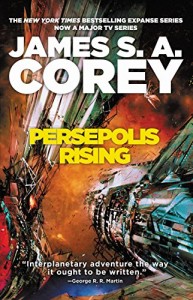 This review originally appeared in SFRevu.com on Dec, 1, 2017
This review originally appeared in SFRevu.com on Dec, 1, 2017
Persepolis Rising is the seventh Expanse novel, and the first in what we expect to be the third story arc. The last novel, Babylon’s Ashes, ended with the establishment of the Transport Union, which gave former OPA types a role in galactic commerce, carving out a few decades of relative quiet while mankind moved out into the galaxy through the hyperspace ring created by the proto-molecule at the end of the first arc (Abaddon’s Gate).
This new arc begins about thirty years after the creation of the ring, and both the Rocinante and her crew are getting creaky after a few decades of playing gunship-for-hire. The story opens with the ship closing in on the colony world of Freehold, a group big on personal freedom and gun ownership but less so on the Transport Union’s right to govern ring traffic. Freehold showed their contempt by sending a transport through without paying the toll, or getting clearance. In response, the Union sent James Holden and the Rocinante to deliver the news that Freehold is being cut off from transit privileges for three years, a death sentence to the not-yet self-sufficient colony.
Naturally Holden changes the rules in the middle of the game, offering the colony an out, and incurring the ire of the Union president, but that’s par for the course for Holden. Still, Jim’s tired of being the stick of convenience for the Union, and he’s ready to take some time to chill out with Naomi somewhere without people shooting at him. Like that’s going to happen.
Back at the end of the first arc, the rebel half of the Martian fleet disappeared into the ring and holed up in the Laconia system, leaving a Do Not Disturb buoy on their side of the ring and a hostile welcome to any probes that went through. Earth, Mars, and the Belters were pretty busy at the time, so they said “Good riddance,” and decided that containment was a sufficient policy. Now the Laconians are ready to come back, and eager to create an empire, starting with Medina station, the massive habitat that was originally a generation ship and which now controls all ring traffic.
Admiral Winston Duarte, ruler of the Laconia colony, and intent on being emperor of all human space, sends two ships to take the station, one a destroyer captained by Santiago Singh, a rising officer in the Laconian navy, and the other a massive battle cruiser. Both ships are the beneficiaries of decades of proto-molecule tech research, and despite the best defenses human technology could give the station, the takeover is a formality. Singh assumes his role as governor of the station, determined to spread the orderly society of Laconia to the solar system and the thousand colonies that have popped up since the opening of the gate.
Wouldn’t you know that James Holden and the gang arrive back from Freehold just before the takeover, which makes a mess of Holden’s plan to retire somewhere quiet, as well as Bobbie Draper’s plans to step up and take charge. Between pissed-off OPA types, Holden with a new crusade, and a Martian Ex-Marine who’s really annoyed by the whole turn of events, Singh is in for a rough time.
Meanwhile, the battle cruiser that came through the gate with Singh’s destroyer is moving on to demonstrate Laconian superiority to the combined forces of the Solar System. The home team hasn’t exactly been sitting on its hands over the past few decades, so you’re guaranteed an epic space battle done the way only James S.A. Corey does it, with credible tech, timing, and terrible consequences.
The first three books in the Expanse series were about discovering the proto-molecule and breaking out of the solar system. The second three were about humanity expanding to the colony worlds and establishing a new balance of power between Earth and the colonies. Persepolis Rising opens the third arc with an old foe returning with aspirations of empire backed with proto-molecule technology.
To misquote Paul Simon, “Hey, empires come and empires go, but what are you going to do about it, that’s what I’d like to know.”
Over the next few books, I expect we’ll get the answer.